Key takeaways:
- Restorative justice emphasizes healing and accountability, shifting the focus from punishment to understanding the human impact of crime.
- The anti-death penalty movement advocates for the intrinsic value of every human life and questions the effectiveness of capital punishment in deterring crime.
- Community involvement in justice processes fosters healing and emphasizes collective responsibility, bridging gaps often overlooked by traditional justice systems.
- Key strategies in restorative justice include creating safe spaces for dialogue, using trained facilitators for guidance, and ensuring accountability for all parties involved.

Understanding restorative justice
Restorative justice is a philosophy that focuses on healing rather than punishment. Instead of asking, “What law was broken?”, it prompts us to consider, “Who was hurt, and how can we make things right?” When I first encountered this approach, I was struck by its emphasis on empathy and accountability—values that resonate deeply with my belief in the power of human connection.
I remember speaking to a survivor of crime who described how a restorative conference with the offender transformed both their lives. They sat across from each other, sharing their stories, and in that moment, what could have been a purely adversarial interaction became a meaningful dialogue. This experience made me realize that understanding the human impact of crime can lead to profound change, fostering healing for all involved.
Additionally, I often wonder why traditional punitive systems sometimes fail to address the root causes of crime. Isn’t it essential to break this cycle? By incorporating restorative practices, we not only address the harm done, but we also work toward restoring relationships and preventing future offenses. This shift in perspective can challenge us to rethink our approach to justice in a more compassionate way.
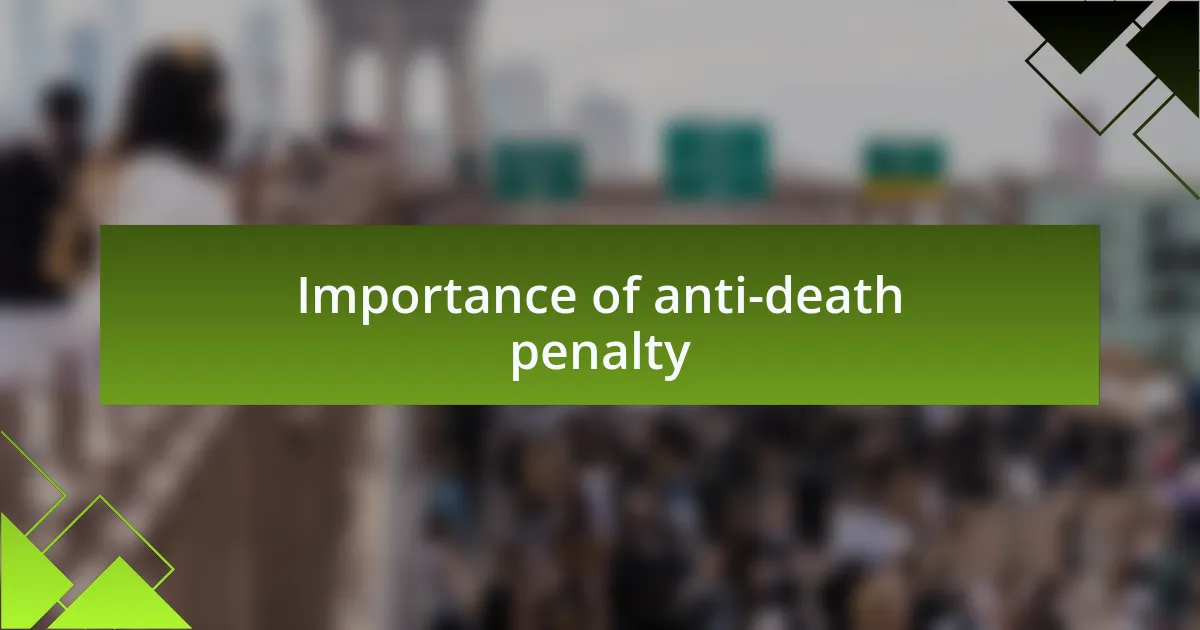
Importance of anti-death penalty
The importance of the anti-death penalty movement is deeply rooted in the belief that every human life has intrinsic value, regardless of the crimes committed. I’ve often reflected on stories of wrongfully convicted individuals who spent years on death row. The thought of an innocent person facing the ultimate punishment haunts me. How can we justify a system that risks taking lives without certainty?
Beyond the issue of wrongful convictions, the death penalty fails to deter crime effectively. Studies I’ve come across show that states without the death penalty often have lower murder rates. It raises a critical question: are we really achieving justice, or are we merely perpetuating a cycle of violence? I think about how much more effort we could invest in prevention and rehabilitation instead.
Moreover, there’s a profound moral argument against state-sanctioned killing. I can’t help but feel that a society’s values are reflected in how it treats its most vulnerable members. Rather than choosing retribution, wouldn’t it be more compassionate to embrace healing and forgiveness? It’s time we align our justice system with principles that honor life and promote restorative justice.
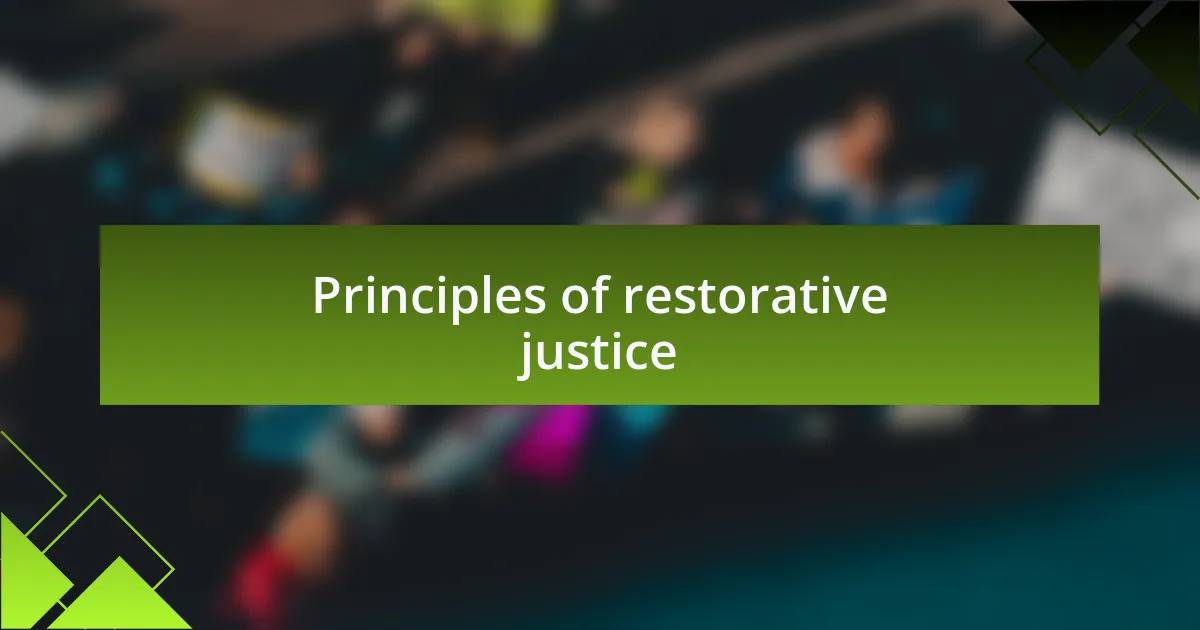
Principles of restorative justice
Restorative justice pivots around the idea of accountability and making amends. Each time I’ve engaged in discussions on this topic, I find that emphasizing dialogue between victims and offenders can foster healing. Isn’t it profound to imagine a scenario where both parties get the chance to speak their truths and find common ground?
Another cornerstone is the focus on repairing the harm caused by criminal behavior. I remember attending a restorative circle where a victim expressed her pain directly to the offender. The emotional exchange was palpable, and it made me realize that justice isn’t just about punishment; it’s about understanding and resolution. How often do we overlook the deep scars left on victims when solely seeking retribution?
Lastly, the involvement of the community is vital. I believe healing happens not just in a vacuum but in a web of relationships. When I think about my own community, I see how collective support can guide both healing for the victim and reform for the offender. Engaging the community transforms justice into a shared responsibility. Isn’t that a more hopeful vision for a society?
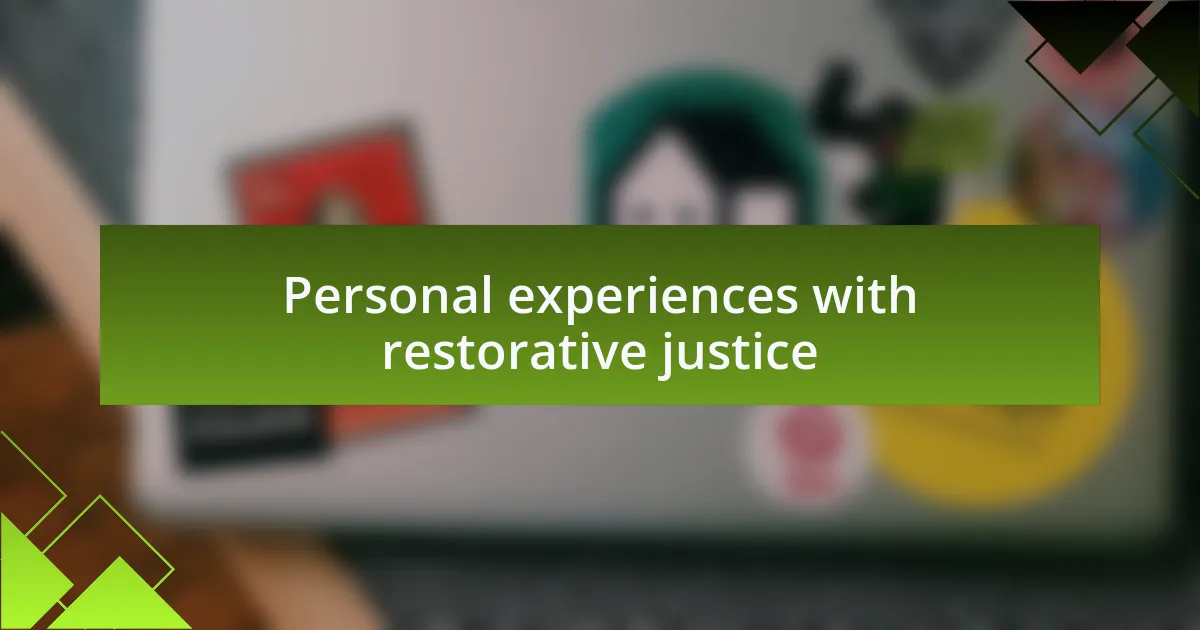
Personal experiences with restorative justice
Engaging with restorative justice has profoundly influenced my perspective. I participated in a mediation session where a young offender met the victim of his crime. The tension in the room melted as they shared their experiences, and I was struck by how the offender’s heartfelt apology transformed his remorse into a desire for change. Have you ever witnessed such a pure moment of connection?
On another occasion, I volunteered with a group that facilitated restorative justice workshops. One participant shared that he had spent years grappling with his past, feeling isolated and ashamed. Through our discussions, he discovered that acknowledging his actions could be the first step toward healing—not just for himself, but for the victims, too. I can’t help but wonder, how many more individuals could find peace through such transformative dialogues?
In a recent restorative justice event, I watched a mother confront the person responsible for her child’s death. Rather than seeking vengeance, she expressed her sorrow and desire for understanding. The room was filled with empathy and raw emotion; it was a reminder that even amid profound grief, there can be a pathway to healing and reconciliation. How powerful is it to consider that forgiveness might ultimately benefit both sides?
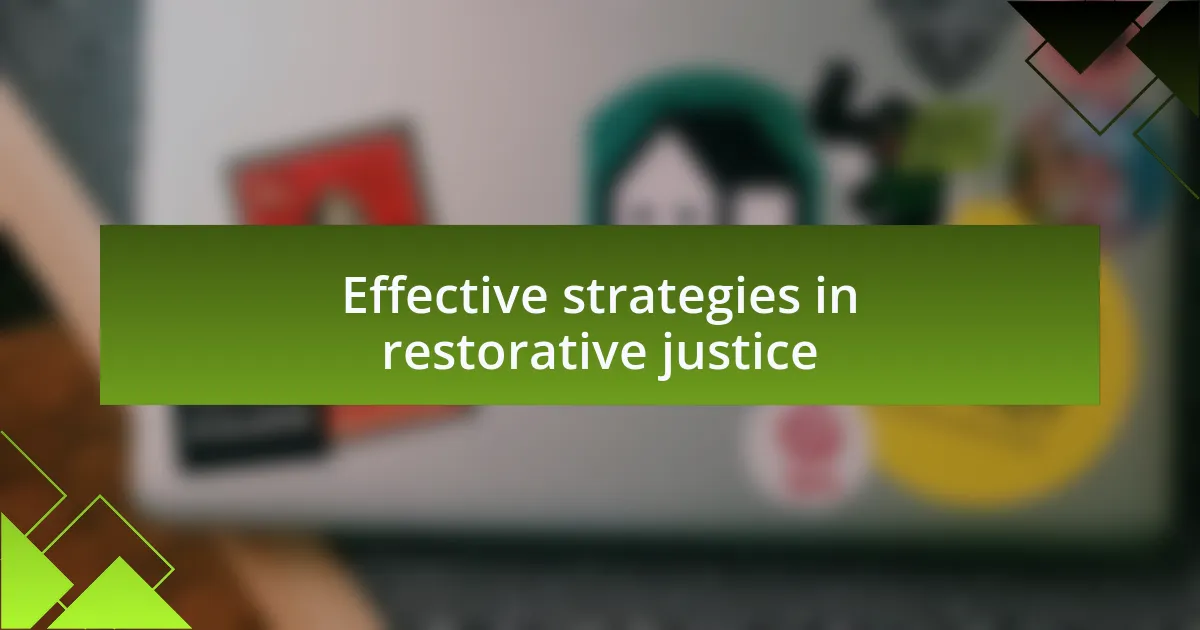
Effective strategies in restorative justice
In my experience, one effective strategy in restorative justice is creating safe spaces for open communication. I recall a session where participants were encouraged to share their stories without judgment. This approach not only fostered honesty but also built a sense of community among those involved. Have you ever felt the weight lift when you could speak openly about your feelings?
Another key strategy is the inclusion of trained facilitators who guide the process. I participated in a workshop led by an experienced mediator who skillfully navigated difficult conversations. Their presence allowed participants to express emotions that might have otherwise led to conflict. It made me realize how essential it is to have someone with expertise in emotional dynamics steering the dialogue.
Lastly, incorporating accountability is vital. I witnessed a participant take responsibility for their actions, and the impact was profound. This admission didn’t just help the victim heal; it sparked a transformative journey for the offender as well. Isn’t it fascinating how facing our truths can open doors to growth and healing for everyone involved?

Community involvement in justice processes
Engaging the community in justice processes is incredibly powerful. I remember attending a community meeting where residents gathered to discuss a recent crime in our neighborhood. The mix of fear and anger was palpable, yet the discussions often shifted towards healing. It made me reflect on how deeply interconnected we all are and how local voices can shape a more compassionate response to wrongdoing.
One striking aspect was witnessing community members taking initiative in restorative practices. At one point, a group organized a dialogue between the offender and the victim’s family, emphasizing the need for understanding rather than mere punishment. Seeing such a commitment from locals made me realize that community-led efforts can bridge gaps that the traditional justice system often overlooks. Have you ever considered how your involvement could change someone’s narrative?
Moreover, I found that community support extends beyond the immediate participants in a justice process. In another instance, locals rallied to provide resources for both the victims and offenders, helping them reintegrate into society. This collective responsibility stands out to me as a fundamental element in restorative justice. Isn’t it inspiring to think that a united community can foster healing and prevent future harm?
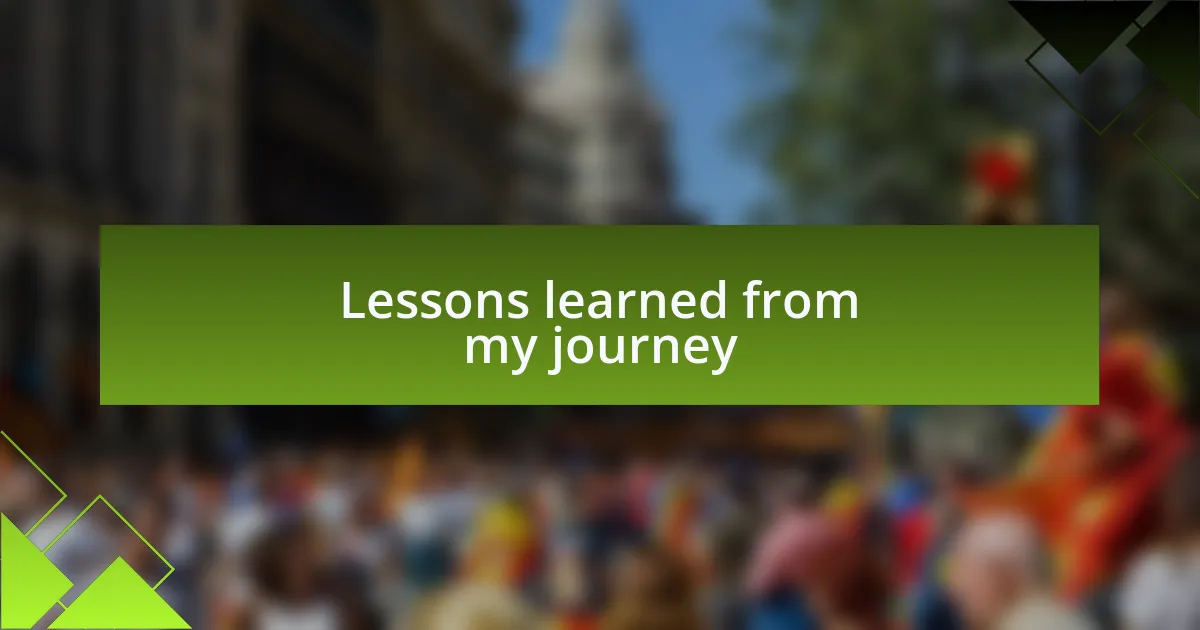
Lessons learned from my journey
Reflecting on my journey, I’ve learned that vulnerability can be a powerful catalyst for change. I vividly remember a moment when a survivor shared their story during a restorative justice circle. Their raw emotion resonated with everyone, breaking down barriers and paving the way for empathy. It struck me then that acknowledging pain is not a weakness; it’s an essential step toward healing. Have you ever found your own strength in sharing your truth?
Another lesson that stands out is the importance of patience in these processes. I once facilitated a meeting where participants initially struggled to find common ground. It was easy to feel frustrated, but as I navigated the conversation slowly, I realized that giving people time to voice their feelings created a safe space. This patience allowed for genuine connections to form, reminding me that real understanding often takes time. Isn’t it fascinating how pauses in dialogue can lead to breakthroughs?
Finally, I discovered that true restorative justice thrives not only on dialogue but also on accountability. During a workshop, I guided offenders in reflecting on their actions and the impact they had on others. It was promising to observe their changing perspectives as they recognized the deeper consequences of their choices. This experience taught me that accountability fuels personal growth and inspires a commitment to do better. How transformative would it be if we all embraced our accountability in our actions?